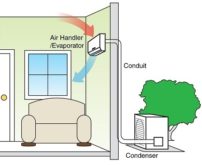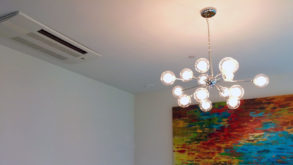Sun rooms and add-ons to homes can make for a nice place to relax and read or create more space for you to store things, do laundry, entertain/accommodate guests, etc. But, most of the time, houses with such built on spaces struggle to keep heated or cooled efficiently. Even closing them off with a door or curtain doesn’t help too much. Do you live in an older home built before central AC was available for homes? Have a gas furnace for heat but no air? If that sounds like your situation or you are considering building on to your home and are looking for a solutions other than having your duct work expanded, a ductless mini split may just be the energy efficient solution you’re looking for.
A mini split, otherwise known as a Ductless Heating System, is exactly what that more formal name suggests. They are HVAC systems that do not employ the use of ducts to move air in order to condition a space. They consist of an outdoor air compressor/condenser and an indoor mounted air handling unit that are connected by a conduit consisting of a power cable, refrigerant and suction lines, and condensation drainage lines.
 A diagram of a ductless system
A diagram of a ductless system
Advantages of Ductless Systems:
- They are an effective means of adequately heating/cooling individual rooms. Like space heaters and window units, they can heat/cool an individual space, but much more safely and with better energy efficiency. Space heaters are a huge fire risk if used improperly. Window units can be a huge source of air leakage if the area around the unit is not sealed well. They are also not limited to just 1 room per system. Up to 4 air handlers can be connected to just one outdoor condenser/compressor, meaning up to 4 rooms can be climate controlled.
- Mini Splits are energy efficient. Duct leakage in regular central HVAC systems can lose up to 30 percent of generated warm or cool air as it moves through the duct work runs. Even when closed off, added spaces with no AC or heat in them can contribute to even more energy and heat wasted as heat or cold air moves into the spaces conditioned by the central unit in the rest of the home, meaning they run longer to heat or cool the rest of the home, leading to greater wear and tear on the system and shortening its lifespan. A ductless system can adequately condition sun rooms, added spaces, or rooms in older homes and take stress off your central system. Depending on the brand of ductless system, you can see a savings of up to 20% per month and up to 40% per year on energy and heating/cooling costs.
- Ductless systems offer flexible options for air handler placement. The handlers can be placed on ceilings, mounted on walls, or even baseboards.


- Like space heaters and fans, they are customizable and can be controlled wirelessly from anywhere. Ductless air handlers come with remote controls to control the temperature, set sleep timers, etc. Some are even compatible with smart home devices such as google home, alexa, etc. They even can be controlled via smart phone apps.
- Mini Splits run very quietly. You’ve no doubt heard the humming and vibrating that outdoor heat pumps and window units make. With most ductless systems, the only noise you’ll hear is the sound of the air blowing out, much like high-end tower fans and the defrost cycle in the winter.
Disadvantages:
- The air handlers are not necessarily pretty to look at. Many homeowners tend to gun for other options when they consider that wall mounted air handlers are not as aesthetically appealing as a traditional supply register (vent) for a central HVAC system. However, many manufacturers have made strides to design sleeker systems that aren’t as immediately noticeable when you walk into a room.
- They MUST be properly placed. Ductless air handlers are a much more compact form of a regular handler. A regular air handler draws conditioned air in through the return register and cycles it back over the condenser coils where either the air is re-cooled by refrigerant, or warmed before being blown back into your ducts and out the vents by the blower. In a ductless handler, the return is at the top of the unit. It draws air in while blowing air out from the bottom. If this influx of air is hindered in any way, it results in running less efficiently. It could also lead to an issue called short-cycling, which is where the system shuts off prematurely only to come right back on a short time later. (Symptom: your compressor is turning on and off frequently and rapidly). This is why it is absolutely imperative that if you are considering installing a mini split to consult an expert HVAC professional. A pro will be able to assess exactly what size unit, number of handlers you need, and the optimal place to mount them in order to achieve peak system performance. (We would love to be able to assist you with that! Just give us a call or contact us on facebook, twitter, or via our website!)
- They require maintenance same as a central HVAC system. The coils need to be cleaned twice per year and the filters cleaned once per month to ensure it runs at optimal efficiency. You can clean the filters yourself, but the coils require professional attention.
Mini split heating systems are definitely a worthwhile option to consider, but they are not necessarily for everyone. If you are considering the ductless option, but don’t know if you can afford it, we offer financing. There are also incentives and rebates you can apply for from local utility companies for energy star certified brands. Just call your energy service provider and ask. If you have any questions, feel free to call on the experts at The Team You Can Trust. We would love to help you in any way that we can.

 A diagram of a ductless system
A diagram of a ductless system
